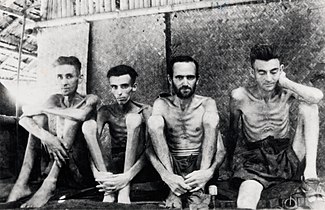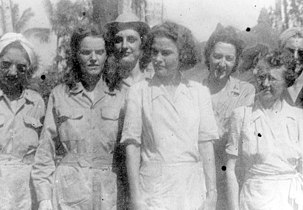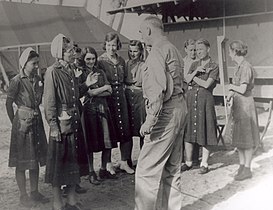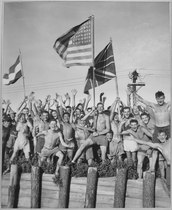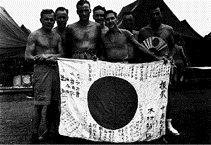Prisoner of war
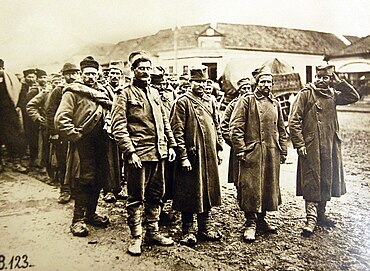
| Part of a series on |
| War (outline) |
|---|
 |
Aprisoner of war(POW) is a person who is heldcaptiveby abelligerentpower during or immediately after anarmed conflict.The earliest recorded usage of the phrase "prisoner of war" dates back to 1610.[a]
Belligerents hold prisoners of war in custody for a range of legitimate and illegitimate reasons, such as isolating them from theenemy combatantsstill in the field (releasing andrepatriatingthem in an orderly manner after hostilities), demonstrating military victory, punishing them, prosecuting them forwar crimes,exploiting them for their labour,recruiting or evenconscriptingthem as their own combatants, collecting military and political intelligence from them, orindoctrinatingthem in new political or religious beliefs.[1]
Ancient times
[edit]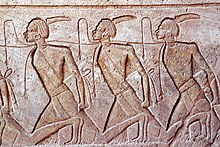
For a large part of human history, prisoners of war would most often be either slaughtered orenslaved.[2]Early Romangladiatorscould be prisoners of war, categorised according to their ethnic roots asSamnites,Thracians,andGauls(Galli).[3]Homer'sIliaddescribes Trojan and Greek soldiers offering rewards of wealth to opposing forces who have defeated them on the battlefield in exchange for mercy, but their offers are not always accepted; seeLycaonfor example.
Typically, victors made little distinction between enemy combatants and enemy civilians, although they were more likely to spare women and children. Sometimes the purpose of a battle, if not of a war, was to capture women, a practice known asraptio;theRape of the Sabinesinvolved, according to tradition, a large mass-abduction by the founders of Rome. Typically women had norights,and were held legally aschattels.[4]
In the fourth century AD, BishopAcacius of Amida,touched by the plight of Persian prisoners captured in a recent war with the Greek Empire, who were held in his town under appalling conditions and destined for a life of slavery, took the initiative in ransoming them by selling his church's precious gold and silver vessels and letting them return to their country. For this he was eventuallycanonised.[5]
Middle Ages and Renaissance
[edit]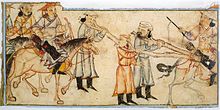
According to legend, duringChilderic's siege and blockade ofParisin 464 the nunGeneviève(later canonised as the city's patron saint) pleaded with the Frankish king for the welfare of prisoners of war and met with a favourable response. Later,Clovis I(r. 481–511) liberated captives after Genevieve urged him to do so.[6]
KingHenry V's English army killed many French prisoners of war after theBattle of Agincourtin 1415.[7]This was done in retaliation for the French killing of the boys and other non-combatants handling the baggage and equipment of the army, and because the French were attacking again and Henry was afraid that they would break through and free the prisoners who would rejoin the fight against the English.
In the laterMiddle Agesa number ofreligious warsaimed to not only defeat but also to eliminate enemies. Authorities inChristian Europeoften considered the extermination ofhereticsandheathensdesirable. Examples of such wars include the 13th-centuryAlbigensian CrusadeinLanguedocand theNorthern Crusadesin theBaltic region.[8]When asked by a Crusader how to distinguish between the Catholics andCatharsfollowing the projected capture (1209) of the city ofBéziers,the papal legateArnaud Amalricallegedly replied, "Kill them all, God will know His own".[b]
Likewise, the inhabitants of conquered cities were frequently massacred during Christians'CrusadesagainstMuslimsin the 11th and 12th centuries.Noblemencould hope to beransomed;their families would have to send to their captors large sums of wealth commensurate with the social status of the captive.
Feudal Japanhad no custom of ransoming prisoners of war, who could expect for the most part summary execution.[9]
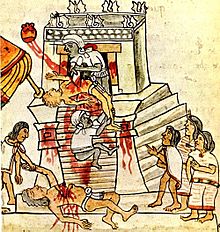
In the 13th century the expandingMongol Empirefamously distinguished between cities or towns that surrendered (where the population was spared but required to support the conquering Mongol army) and those that resisted (in which case the city wasransacked and destroyed,and all the population killed). InTermez,on theOxus:"all the people, both men and women, were driven out onto the plain, and divided in accordance with their usual custom, then they were all slain".[10]
TheAztecswarredconstantly with neighbouring tribes and groups, aiming to collect live prisoners forsacrifice.[11]For the re-consecration ofGreat Pyramid of Tenochtitlanin 1487, "between 10,000 and 80,400 persons" were sacrificed.[12][13]
During theearly Muslim conquestsof 622–750, Muslims routinely captured large numbers of prisoners. Aside from those who converted, most were ransomed orenslaved.[14][15]Christians captured during the Crusades were usually either killed or sold into slavery if they could not pay a ransom.[16]During his lifetime (c. 570– 632),Muhammadmade it the responsibility of the Islamic government to provide food and clothing, on a reasonable basis, to captives, regardless of their religion; however, if the prisoners were in the custody of a person, then the responsibility was on the individual.[17]On certain occasions where Muhammad felt the enemy had broken a treaty with the Muslims he endorsed the mass execution of male prisoners who participated in battles, as in the case of theBanu Qurayzain 627. The Muslims divided up the females and children of those executed asghanima(spoils of war).[18]
Modern times
[edit]
In Europe, the treatment of prisoners of war became increasingly centralised, in the time period between the 16th and late 18th century. Whereas prisoners of war had previously been regarded as the private property of the captor, captured enemy soldiers became increasingly regarded as the property of the state. The European states strove to exert increasing control over all stages of captivity, from the question of who would be attributed the status of prisoner of war to their eventual release. The act of surrender was regulated so that it, ideally, should be legitimised by officers, who negotiated the surrender of their whole unit.[19]Soldiers whose style of fighting did not conform to the battle line tactics of regular European armies, such asCossacksandCroats,were often denied the status of prisoners of war.[20]
In line with this development the treatment of prisoners of war became increasingly regulated in international treaties, particularly in the form of the so-called cartel system, which regulated how the exchange of prisoners would be carried out between warring states.[21]Another such treaty was the 1648Peace of Westphalia,which ended theThirty Years' War.This treaty established the rule that prisoners of war should be released without ransom at the end of hostilities and that they should be allowed to return to their homelands.[22]
There also evolved theright ofparole,French for "discourse", in which a captured officer surrendered his sword and gave his word as a gentleman in exchange for privileges. If he swore not to escape, he could gain better accommodations and the freedom of the prison. If he swore to cease hostilities against the nation who hold him captive, he could be repatriated or exchanged but could not serve against his former captors in a military capacity.
European settlers captured in North America
[edit]Early historical narratives of captured European settlers, including perspectives of literate women captured by theindigenous peoples of North America,exist in some number. The writings ofMary Rowlandson,captured in the chaotic fighting ofKing Philip's War,are an example. Such narratives enjoyed some popularity, spawning a genre of thecaptivity narrative,and had lasting influence on the body of early American literature, most notably through the legacy ofJames Fenimore Cooper'sThe Last of the Mohicans.Some Native Americans continued to capture Europeans and use them both as labourers and bargaining chips into the 19th century; see for exampleJohn R. Jewitt,a sailor who wrote a memoir about his years as a captive of theNootkapeople on thePacific Northwestcoast from 1802 to 1805.
French Revolutionary wars and Napoleonic wars
[edit]The earliest known purpose-builtprisoner-of-war campwas established atNorman Crossin Huntingdonshire, England in 1797 to house the increasing number of prisoners from theFrench Revolutionary Warsand theNapoleonic Wars.[23]The average prison population was about 5,500 men. The lowest number recorded was 3,300 in October 1804 and 6,272 on 10 April 1810 was the highest number of prisoners recorded in any official document.Norman Cross Prisonwas intended to be a model depot providing the most humane treatment of prisoners of war. The British government went to great lengths to provide food of a quality at least equal to that available to locals. The senior officer from each quadrangle was permitted to inspect the food as it was delivered to the prison to ensure it was of sufficient quality. Despite the generous supply and quality of food, some prisoners died of starvation after gambling away their rations. Most of the men held in the prison were low-ranking soldiers and sailors, including midshipmen and junior officers, with a small number ofprivateers.About 100 senior officers and some civilians "of good social standing", mainly passengers on captured ships and the wives of some officers, were givenparoleoutside the prison, mainly inPeterboroughalthough some further afield. They were afforded the courtesy of their rank within English society.
During theBattle of Leipzigboth sides used thecity's cemeteryas alazaretand prisoner camp for around 6,000 POWs who lived in theburial vaultsand used the coffins for firewood. Food was scarce and prisoners resorted to eating horses, cats, dogs or even human flesh. The bad conditions inside the graveyard contributed to a city-wide epidemic after the battle.[24][25]
Prisoner exchanges
[edit]The extensive period of conflict during theAmerican Revolutionary WarandNapoleonic Wars(1793–1815), followed by theAnglo-AmericanWar of 1812,led to the emergence of acartelsystem for theexchange of prisoners,even while the belligerents were at war. A cartel was usually arranged by the respective armed service for the exchange of like-ranked personnel. The aim was to achieve a reduction in the number of prisoners held, while at the same time alleviating shortages of skilled personnel in the home country.[citation needed]
American Civil War
[edit]
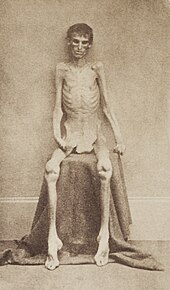
At the start of the American Civil War a system of paroles operated. Captives agreed not to fight until they were officially exchanged. Meanwhile, they were held in camps run by their own army where they were paid but not allowed to perform any military duties.[26]The system of exchanges collapsed in 1863 when the Confederacy refused to exchange black prisoners. In the late summer of 1864, a year after theDix–Hill Cartelwas suspended, Confederate officials approached Union General Benjamin Butler, Union Commissioner of Exchange, about resuming the cartel and including the black prisoners. Butler contacted Grant for guidance on the issue, and Grant responded to Butler on 18 August 1864 with his now famous statement. He rejected the offer, stating in essence, that the Union could afford to leave their men in captivity, the Confederacy could not.[27]After that about 56,000 of the 409,000 POWs died in prisons during theAmerican Civil War,accounting for nearly 10% of the conflict's fatalities.[28]Of the 45,000 Union prisoners of war confined inCamp Sumter,located nearAndersonville, Georgia,13,000 (28%) died.[29]AtCamp Douglasin Chicago, Illinois, 10% of its Confederate prisoners died during one cold winter month; andElmira Prisonin New York state, with a death rate of 25% (2,963), nearly equalled that of Andersonville.[30]
Amelioration
[edit]During the 19th century, there were increased efforts to improve the treatment and processing of prisoners. As a result of these emerging conventions, a number of international conferences were held, starting with the Brussels Conference of 1874, with nations agreeing that it was necessary to prevent inhumane treatment of prisoners and the use of weapons causing unnecessary harm. Although no agreements were immediately ratified by the participating nations, work was continued that resulted in newconventionsbeing adopted and becoming recognised asinternational lawthat specified that prisoners of war be treated humanely and diplomatically.
Hague and Geneva Conventions
[edit]Chapter II of the Annex to the1907 Hague ConventionIV – The Laws and Customs of War on Landcovered the treatment of prisoners of war in detail. These provisions were further expanded in the1929 Geneva Convention on the Prisoners of Warand were largely revised in theThird Geneva Conventionin 1949.
Article 4 of the Third Geneva Convention protects capturedmilitary personnel,someguerrillafighters, and certaincivilians.It applies from the moment a prisoner is captured until his or her release or repatriation. Under the 1949Geneva Conventions,POWs acquires the status ofprotected persons,meaning it is a war crime by the detaining power to deprive the rights afforded to them by the Third Convention's provisions.[31]Article 17 of the Third Geneva Convention states that POWs can only be required to give theirname,date of birth,rankandservice number(if applicable).
TheICRChas a special role to play, with regards tointernational humanitarian law,inrestoring and maintaining family contact in times of war,in particular concerning the right of prisoners of war and internees to send and receive letters and cards (Geneva Convention (GC) III, art. 71 and GC IV, art. 107).
However, nations vary in their dedication to following these laws, and historically the treatment of POWs has varied greatly. During World War II,Imperial JapanandNazi Germany(towards Soviet POWs and Western Allied commandos) were notorious for atrocities against prisoners of war. The German military used the Soviet Union's refusal to sign the Geneva Convention as a reason for not providing the necessities of life to Soviet POWs; and the Soviets also used Axis prisoners as forced labour. The Germans also routinely executed Allied commandos captured behind German lines per theCommando Order.
Qualifications
[edit]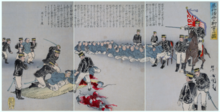
To be entitled to prisoner-of-war status, captured persons must belawful combatantsentitled to combatant's privilege—which gives them immunity from punishment for crimes constituting lawful acts of war such as killingenemy combatants.To qualify under theThird Geneva Convention,a combatant must be part of achain of command,wear a "fixed distinctive marking, visible from a distance", bear arms openly, and have conducted military operations according to thelaws and customs of war.(The Convention recognises a few other groups as well, such as "[i]nhabitants of a non-occupied territory, who on the approach of the enemy spontaneously take up arms to resist the invading forces, without having had time to form themselves into regular armed units".)
Thus, uniforms and badges are important in determining prisoner-of-war status under the Third Geneva Convention. UnderAdditional Protocol I,the requirement of a distinctive marking is no longer included.Francs-tireurs,militias,insurgents,terrorists,saboteurs,mercenaries,andspiesgenerally do not qualify because they do not fulfill the criteria of Additional Protocol I. Therefore, they fall under the category ofunlawful combatants,or more properly they are not combatants. Captured soldiers who do not get prisoner of war status are still protected like civilians under theFourth Geneva Convention.
The criteria are applied primarily tointernationalarmed conflicts. The application of prisoner of war status in non-international armed conflicts likecivil warsis guided byAdditional Protocol II,butinsurgentsare often treated astraitors,terroristsorcriminalsby government forces and are sometimes executed on spot or tortured. However, in theAmerican Civil War,both sides treated captured troops as POWs presumably out ofreciprocity,although theUnionregardedConfederatepersonnel as separatist rebels. However, guerrillas and other irregular combatants generally cannot expect to receive benefits from both civilian and military status simultaneously.
Rights
[edit]Under theThird Geneva Convention,prisoners of war (POW) must be:
- Treated humanely with respect for their persons and their honour
- Able to inform their next of kin and theInternational Committee of the Red Crossof their capture
- Allowed to communicate regularly with relatives and receive packages
- Given adequate food, clothing, housing, and medical attention
- Paid for work done and not forced to do work that is dangerous, unhealthy, or degrading
- Released quickly after conflicts end
- Not compelled to give any information except for name, age, rank, and service number[32]
In addition, if wounded or sick on the battlefield, the prisoner will receive help from the International Committee of the Red Cross.[33]
When a country is responsible for breaches of prisoner of war rights, those accountable will be punished accordingly. An example of this is theNurembergandTokyo Trials.German and Japanese military commanders were prosecuted for preparing and initiating awar of aggression,murder,ill treatment, anddeportationof individuals, andgenocideduring World War II.[34]Most were executed or sentenced to life in prison for their crimes.
U.S. Code of Conduct and terminology
[edit]The United States Military Code of Conductwas promulgated in 1955 viaExecutive Order 10631underPresidentDwight D. Eisenhowerto serve as a moral code for United States service members who have been taken prisoner. It was created primarily in response to the breakdown of leadership and organisation, specifically when U.S. forces were POWs during theKorean War.
When a military member is taken prisoner, the Code of Conduct reminds them that the chain of command is still in effect (the highest ranking service member eligible for command, regardless of service branch, is in command), and requires them to support their leadership. The Code of Conduct also requires service members to resist giving information to the enemy (beyond identifying themselves, that is, "name, rank, serial number" ), receiving special favours or parole, or otherwise providing their enemy captors aid and comfort.
Since theVietnam War,the official U.S. military term for enemy POWs is EPW (Enemy Prisoner of War). This name change was introduced in order to distinguish between enemy and U.S. captives.[35]
In 2000, the U.S. military replaced the designation "Prisoner of War" for captured American personnel with "Missing-Captured". A January 2008 directive states that the reasoning behind this is since "Prisoner of War" is the international legal recognised status for such people there is no need for any individual country to follow suit. This change remains relatively unknown even among experts in the field and "Prisoner of War" remains widely used in the Pentagon which has a "POW/Missing Personnel Office" and awards thePrisoner of War Medal.[36][37]
World War I
[edit]
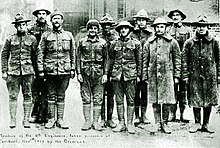
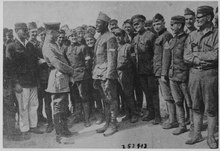

During World War I, about eight million men surrendered and were held in POW camps until the war ended. All nations pledged to follow the Hague rules on fair treatment of prisoners of war, and in general the POWs had a much higher survival rate than their peers who were not captured.[39]Individual surrenders were uncommon; usually a large unit surrendered all its men. AtTannenberg92,000 Russians surrendered during the battle. When the besieged garrison ofKaunassurrendered in 1915, 20,000 Russians became prisoners. Over half the Russian losses were prisoners as a proportion of those captured, wounded or killed. About 3.3 million men became prisoners.[40]
TheGerman Empireheld 2.5 million prisoners;Russiaheld 2.9 million, andBritainandFranceheld about 720,000, mostly gained in the period just before theArmisticein 1918. The US held 48,000. The most dangerous moment for POWs was the act of surrender, when helpless soldiers were sometimes killed or mistakenly shot down. Once prisoners reached a POW camp conditions were better (and often much better than in World War II), thanks in part to the efforts of theInternational Red Crossand inspections by neutral nations.
There was much harsh treatment of POWs in Germany, as recorded by the American ambassador (prior to America's entry into the war), James W. Gerard, who published his findings in "My Four Years in Germany". Even worse conditions are reported in the book "Escape of a Princess Pat" by the Canadian George Pearson. It was particularly bad in Russia, where starvation was common for prisoners and civilians alike; a quarter of the over 2 million POWs held there died.[41]Nearly 375,000 of the 500,000Austro-Hungarianprisoners of war taken by Russians perished inSiberiafromsmallpoxandtyphus.[42]In Germany, food was short, but only 5 per cent died.[43][44][45]
TheOttoman Empireoften treated prisoners of war poorly[citation needed].Some 11,800 British soldiers, most from theBritish Indian Army,became prisoners after the five-monthSiege of Kut,inMesopotamia,in April 1916. Many were weak and starved when they surrendered and 4,250 died in captivity.[46]
During theSinai and Palestine campaign217 Australian and unknown numbers of British, New Zealand and Indian soldiers were captured by Ottoman forces. About 50 per cent of the Australian prisoners were light horsemen including 48 missing believed captured on 1 May 1918 in the Jordan Valley.Australian Flying Corpspilots and observers were captured in the Sinai Peninsula, Palestine and the Levant. One third of all Australian prisoners were captured on Gallipoli including the crew of the submarine AE2 which made a passage through the Dardanelles in 1915. Forced marches and crowded railway journeys preceded years in camps where disease, poor diet and inadequate medical facilities prevailed. About 25 per cent of other ranks died, many from malnutrition, while only one officer died.[47][48]The most curious case came in Russia where theCzechoslovak LegionofCzechoslovakprisoners (from theAustro-Hungarianarmy) who were released and armed to fight on the side of the Entente, who briefly served as a military and diplomatic force during theRussian Civil War.
Release of prisoners
[edit]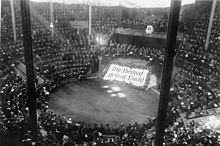
At the end of the war in 1918 there were believed to be 140,000 British prisoners of war in Germany, including thousands of internees held in neutral Switzerland.[49]The first British prisoners were released and reachedCalaison 15 November. Plans were made for them to be sent viaDunkirktoDoverand a large reception camp was established at Dover capable of housing 40,000 men, which could later be used fordemobilisation.
On 13 December 1918, the armistice was extended and the Allies reported that by 9 December 264,000 prisoners had been repatriated. A very large number of these had been releaseden masseand sent across Allied lines without any food or shelter. This created difficulties for the receiving Allies and many ex-prisoners died from exhaustion. The released POWs were met bycavalrytroops and sent back through the lines in lorries to reception centres where they were refitted with boots and clothing and dispatched to the ports in trains.
Upon arrival at the receiving camp the POWs were registered and "boarded" before being dispatched to their own homes. Allcommissioned officershad to write a report on the circumstances of their capture and to ensure that they had done all they could to avoid capture. Each returning officer and man was given a message from KingGeorge V,written in his own hand and reproduced on a lithograph.
The Queen joins me in welcoming you on your release from the miseries & hardships, which you have endured with so much patience and courage.
During these many months of trial, the early rescue of our gallant Officers & Men from the cruelties of their captivity has been uppermost in our thoughts.
We are thankful that this longed for day has arrived, & that back in the old Country you will be able once more to enjoy the happiness of a home & to see good days among those who anxiously look for your return.
— George R.I.[50]
While the Allied prisoners were sent home at the end of the war, the same treatment was not granted toCentral Powersprisoners of the Allies and Russia, many of whom had to serve asforced labour,e.g. in France, until 1920. They were released after many approaches by theICRCto theAllied Supreme Council.[51]
World War II
[edit]
HistorianNiall Ferguson,in addition to figures fromKeith Lowe,tabulated the total death rate for POWs in World War II as follows:[52][53]
| Category | Percentage of POWs that died | |
|---|---|---|
| Captives | Captors | |
| Chinese | Japanese | Almost 100%[54] |
| USSR | Germans | 57.5% |
| Germans | Yugoslavs | 41.2% |
| Germans | USSR | 35.8% |
| Americans | Japanese | 33.0% |
| Germans | Eastern Europeans | 32.9% |
| British | Japanese | 24.8% |
| French | Germans | 4.1% |
| British | Germans | 3.5% |
| Germans | French | 2.6% |
| Americans | Germans | 1.2% |
| Germans | Americans | 0.2% |
| Germans | British | <0.1% |
Treatment of POWs by the Axis
[edit]Empire of Japan
[edit]TheEmpire of Japan,which had signed but never ratified the1929 Geneva Convention on Prisoners of War,[55]did not treat prisoners of war in accordance with international agreements, including provisions of theHague Conventions,either during theSecond Sino-Japanese Waror during thePacific War,because the Japanese viewed surrender as dishonorable. Moreover, according to a directive ratified on 5 August 1937 byEmperor Hirohito,the constraints of the Hague Conventions were explicitly removed on Chinese prisoners of war.[56]
Prisoners of war from China, the United States, Australia, Britain, Canada, India, the Netherlands, New Zealand, and the Philippines held by Japanese imperial armed forces were subject to murder, beatings, extrajudicial punishment, brutal treatment,slavery,medical experiments,starvation rations, poor medical treatment andcannibalism.[57][58]The most notorious use of forced labour was in the construction of the Burma–ThailandDeath Railway.After 20 March 1943, the Imperial Navy was ordered to kill prisoners of war taken at sea.[59]After theArmistice of Cassibile,Italian soldiers and civilians in East Asia were taken as prisoners of war by Japanese armed forces and subject to the same conditions as other POWs.[60]
According to the findings of theTokyo Tribunal,the death rate of Western prisoners was 27.1 per cent, seven times that of POWs under the Germans and Italians.[61]The death rate of Chinese was much higher. Thus, while 37,583 prisoners from the United Kingdom, Commonwealth, and Dominions, 28,500 from the Netherlands, and 14,473 from the United States were released after thesurrender of Japan,the number for the Chinese was only 56.[61][62]The 27,465United States ArmyandUnited States Army Air ForcesPOWs in the Pacific Theater had a 40.4 per cent death rate.[63]The War Ministry in Tokyo issued an order at the end of the war to kill the remaining POWs.[64]
No direct access to the POWs was provided to theInternational Red Cross.Escapes among Caucasian prisoners were almost impossible because of the difficulty of hiding in Asiatic societies.[65]
Allied POW camps and ship-transports were sometimes accidental targets of Allied attacks. The number of deaths which occurred when Japanese "hell ships"—unmarked transport ships in which POWs were transported in harsh conditions—were attacked byU.S. Navysubmarineswas particularly high. Gavan Daws has calculated that "of all POWs who died in the Pacific War, one in three was killed on the water by friendly fire".[66]Daws states that 10,800 of the 50,000 POWs shipped by the Japanese were killed at sea[67]while Donald L. Miller states that "approximately 21,000 Allied POWs died at sea, about 19,000 of them killed by friendly fire."[68]
Life in the POW camps was recorded at great risk to themselves by artists such asJack Bridger Chalker,Philip Meninsky,Ashley George Old,andRonald Searle.Human hair was often used for brushes, plant juices and blood for paint, toilet paper as the "canvas". Some of their works were used as evidence in the trials of Japanese war criminals.
Female prisoners (detainees) atChangi PrisoninSingapore,recorded their ordeal in seemingly harmless prison quilt embroidery.[69]
Research into the conditions of the camps has been conducted by The Liverpool School of Tropical Medicine.[70]
-
Troops of theSuffolk Regimentsurrendering to the Japanese, 1942
-
Many US and Filipino POWs died on theBataan Death March,in May 1942
-
Water colour sketch of "Dusty" Rhodes byAshley George Old
-
Australian and Dutch POWs at Tarsau, Thailand in 1943
-
U.S. Navy nursesrescued from Los Baños Internment Camp, March 1945
-
Allied prisoners of war atAomori campnearYokohama,Japan, waving flags of the United States, Great Britain, and the Netherlands in August 1945
-
Canadian POWs at theLiberation of Hong Kong
-
Malnourished Australian POWs forced to work at the Aso mining company, August 1945
-
POW art depictingCabanatuan prison camp,produced in 1946
-
Australian POWLeonard Siffleetcaptured at New Guinea moments before his execution with a Japaneseshin guntosword in 1943
-
Captured soldiers of the British Indian Army executed by the Japanese
Germany
[edit]French soldiers
[edit]After the French armies surrendered in summer 1940, Germany seized two million French prisoners of war and sent them to camps in Germany. About one third were released on various terms. Of the remainder, the officers and non-commissioned officers were kept in camps and did not work. The privates were sent out to work. About half of them worked for German agriculture, where food supplies were adequate and controls were lenient. The others worked in factories or mines, where conditions were much harsher.[71]
Western Allies' POWs
[edit]Germany and Italy generally treated prisoners from theBritish EmpireandCommonwealth,France, the U.S., and other western Allies in accordance with theGeneva Convention,which had been signed by these countries.[72]Consequently, western Allied officers were not usually made to work and some personnel of lower rank were usually compensated, or not required to work either. The main complaints of western Allied prisoners of war inGermanPOW camps—especially during the last two years of the war—concerned shortages of food.
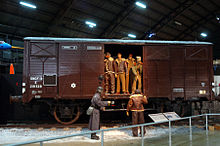
Only a small proportion of western Allied POWs who wereJews—or whom the Nazis believed to be Jewish—were killed as part ofthe Holocaustor were subjected to otherantisemiticpolicies.[73]For example, MajorYitzhak Ben-Aharon,aPalestinian Jewwho had enlisted in the British Army, and who was captured by the Germans inGreece in 1941,experienced four years of captivity under entirely normal conditions for POWs.[74]
A small number of Allied personnel were sent to concentration camps, for a variety of reasons including being Jewish.[75]As the US historian Joseph Robert White put it: "An important exception... is the sub-camp for U.S. POWs atBerga an der Elster,officially calledArbeitskommando625[also known asStalag IX-B]. Berga was the deadliest work detachment for American captives in Germany. 73 men who participated, or 21 percent of the detachment, perished in two months. 80 of the 350 POWs were Jews. "[76]Another well-known example was a group of 168 Australian, British, Canadian,New Zealandand US aviators who were held for two months atBuchenwald concentration camp;[77]two of the POWs died at Buchenwald. Two possible reasons have been suggested for this incident: German authorities wanted to make an example ofTerrorflieger( "terrorist aviators" ) or these aircrews were classified as spies, because they had been disguised as civilians or enemy soldiers when they were apprehended.

Information on conditions in the stalags is contradictory depending on the source. Some American POWs claimed the Germans were victims of circumstance and did the best they could, while others accused their captors of brutalities and forced labour. In any case, the prison camps were miserable places where food rations were meager and conditions squalid. One American admitted "The only difference between the stalags and concentration camps was that we weren't gassed or shot in the former. I do not recall a single act of compassion or mercy on the part of the Germans." Typical meals consisted of a bread slice and watery potato soup which was still more substantial than what Soviet POWs or concentration camp inmates received. Another prisoner stated that "The German plan was to keep us alive, yet weakened enough that we wouldn't attempt escape."[78]
As the Red Army approached some POW camps in early 1945, German guards forced western Allied POWsto walklong distances towards central Germany, often in extreme winter weather conditions.[79]It is estimated that, out of 257,000 POWs, about 80,000 were subject to such marches and up to 3,500 of them died as a result.[80]
Italian POWs
[edit]In September 1943 after the Armistice, Italian officers and soldiers in many places waiting for orders were arrested by Germans and Italian fascists and taken to internment camps in Germany or Eastern Europe, where they were held for the duration of the war. The International Red Cross could do nothing for them, as they were not regarded as POWs, but the prisoners held the status of "military internees".Treatment of the prisoners was generally poor. The authorGiovannino Guareschiwas among those interned and wrote about this time in his life. The book was translated and published asMy Secret Diary.He wrote about semi-starvation, the casual murder of individual prisoners by guards and how, when they were released (now from a German camp), they found a deserted German town filled with foodstuffs that they (with other released prisoners) ate.[citation needed].It is estimated that of the 700,000 Italians taken prisoner by the Germans, around 40,000 died in detention and more than 13,000 lost their lives during the transportation from the Greek islands to the mainland.[81]
Eastern European POWs
[edit]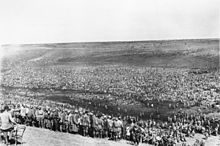
Between 1941 and 1945 the Axis powers took about 5.7 million Soviet prisoners. About one million of them were released during the war, in that their status changed but they remained under German authority. A little over 500,000 either escaped or were liberated by the Red Army. Some 930,000 more were found alive in camps after the war. The remaining 3.3 million prisoners (57.5% of the total captured) died during their captivity.[83]Between the launching ofOperation Barbarossain the summer of 1941 and the following spring, 2.8 million of the 3.2 million Soviet prisoners taken died while in German hands.[84]According to Russian military historian GeneralGrigoriy Krivosheyev,the Axis powers took 4.6 million Soviet prisoners, of whom 1.8 million were found alive in camps after the war and 318,770 were released by the Axis during the war and were then drafted into the Soviet armed forces again.[85]By comparison, 8,348 Western Allied prisoners died in German camps during 1939–45 (3.5% of the 232,000 total).[86]
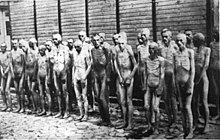
The Germans officially justified their policy on the grounds that the Soviet Union had not signed the Geneva Convention. Legally, however, under article 82 of theGeneva Convention,signatory countries had to give POWs of all signatory and non-signatory countries the rights assigned by the convention.[87]Shortly after the German invasion in 1941, the USSR made Berlin an offer of a reciprocal adherence to theHague Conventions.Third Reich officials left the Soviet "note" unanswered.[88][89]
Romania
[edit]Soviet POWs
[edit]Between 1941 and 1944, 91,060 Soviet prisoners of war were captured by theRomanian Army.Until August 1944, 5,221 Soviet prisoners died in Romanian camps mainly to disease during winter. The POWs were treated according to the 1929 Geneva Convention, which was ratified by Romania on 15 September 1931. Initially, the prisoners were held in five POW camps inVulcan,Găești,Drăgășani,AlexandriaandSlobozia.By 1942, the number reached 12 camps of which 10 were in Romania, and two inTransnistriaatTiraspolandOdesa.As the frontline moved further away, the captured prisoners were given to German POW camps, and then they were transferred to Romanian ones after requests from the Romanian authorities.[90]

In the winter of 1941/1942, the conditions of the POW camps were unsatisfactory, leading to the deaths of prisoners due to various diseases. The conditions were improved in 1942 when, by order of MarshalIon Antonescu,the organisations leading the camps were to permanently control how the prisoners were accommodated, cared for, fed, and used. Due to some problems that arose with the food allowance in 1942, it was decided that the prisoners were to be fed like the Romanian troops, with an allocated 30leiper soldier per day.[90]
In accordance with Article 27 of the Geneva Convention, the POWs were used in various productive activities. In return for providing work, the prisoners were granted payment and accommodation, as well as free time for cleaning, rest, and religious or other activities by their employers, according to the contracts signed with the commanders of the prison camps. The main workplaces for prisoners were in agriculture and industrial enterprises, but also in forestry, civil works, and in service of the POW camps.[90]
For correspondence with their families, the prisoners were provided with postcards. However, most of these were not used as the POWs feared reprisals from the Soviet authorities upon learning that they were prisoners in Romania. The punishment of POWs in the Romanian camps was applied following the regulations of the Romanian Army. Executions by firing squad were few. The escapees who were caught and did not commit any acts of sabotage or espionage were tried bycourt-martialand sentenced to prison terms from 3-6 months to several years. After 23 August 1944, the Soviet POWs were handed over to the Soviet headquarters.[90]
Western Allies' POWs
[edit]
The first Americans were captured in Romania followingOperation Tidal Wave.The airmen were interned at first in the court of the Central Seminary inBucharest,with the wounded airmen taken to the no. 415 Hospital inSinaia.After Marshal Antonescu's visits, a new camp was to be set up, and the prisoners were to be treated according to the Geneva Convention. In September, all 110 POWs were transferred to the villas belonging to the Brașov and Giurgiu City Halls atTimișul de Jos,in the newly established Camp No. 14 (Lagărul de prizonieri nr. 14).[91]The excellent living conditions at the camp earned it the nickname "gilded cage", with the prisoners describing it as "probably the best prison camp in the world".[92]The treatment of the Allied POWs was overlooked by PrincessCatherine Caradja,who was nicknamed "The Angel of Ploiești" by the airmen.[93]
In the spring of 1944, with the increasing number of American and British prisoners due to therestarted air campaign,a new camp was set up in Bucharest.[91]Camp No. 13 from Bucharest was initially located within the barracks of the6th Guard Regiment "Mihai Viteazul",in a frequently bombed area.[94]It was later moved to theNormal Schoolon St. Ecaterina Street. In June 1944, the non-commissioned officers were transferred to a wing of the"Regina Elisabeta" Military Hospital.After 23 August, at the request of the prisoners to be organised into a military unit, GeneralMihail Racovițăapproved the transfer of 896 POWs to the barracks of the 4thVânătoriRegiment. All Western Allied POWs were evacuated to Italy duringOperation Reunionfrom 31 August to 3 September.[91][93]
Treatment of POWs by the Soviet Union
[edit]Germans, Romanians, Italians, Hungarians, Finns
[edit]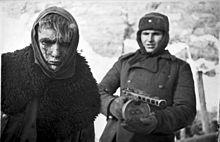

According to some sources, the Soviets captured 3.5 millionAxisservicemen (excluding Japanese), of whom more than a million died.[95]One specific example is that of the German POWs after theBattle of Stalingrad,where the Soviets captured 91,000 German troops in total (completely exhausted, starving and sick), of whom only 5,000 survived the captivity.
German soldiers were kept as forced labour for many years after the war. The last German POWs likeErich Hartmann,the highest-scoringfighter acein the history ofaerial warfare,who had been declared guilty ofwar crimesbut withoutdue process,were not released by the Soviets until 1955, two years after Stalin died.[96]
Polish
[edit]
As a result of theSoviet invasion of Polandin 1939, hundreds of thousands of Polish soldiers becameprisoners of war in the Soviet Union.Thousands were executed; over 20,000 Polish military personnel and civilians perished in theKatyn massacre.[97]Out ofAnders' 80,000 evacuees from the Soviet Union in the United Kingdom, only 310 volunteered to return to Poland in 1947.[98]
Of the 230,000 Polish prisoners of war taken by the Soviet army, only 82,000 survived.[99]
Japanese
[edit]After theSoviet–Japanese War,560,000 to 760,000Japanese prisoners of warwere captured by the Soviet Union. The prisoners were captured inManchuria,Korea, SouthSakhalinand theKuril Islands,then sent to work as forced labour in the Soviet Union andMongolia.[100]An estimated 60,000 to 347,000 of these Japanese prisoners of war died in captivity.[101][102][103][104]
Americans
[edit]Stories that circulated during the Cold War claimed 23,000 Americans held in German POW camps had been seized by the Soviets and never been repatriated. The claims had been perpetuated after the release of people likeJohn H. Noble.Careful scholarly studies demonstrated that this was a myth based on the misinterpretation of a telegram about Soviet prisoners held in Italy.[105]
Treatment of POWs by the Western Allies
[edit]Germans
[edit]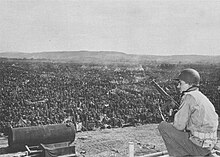


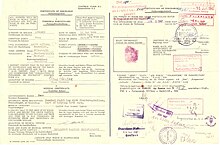
of a German General
(Front- and Backside)
During the war, the armies of Western Allied nations such as Australia, Canada, the UK and the US[106]were given orders to treatAxisprisoners strictly in accordance with theGeneva Convention.[107]Some breaches of the Convention took place, however. According toStephen E. Ambrose,of the roughly 1,000 US combat veterans he had interviewed, only one admitted to shooting a prisoner, saying he "felt remorse, but would do it again". However, one-third of interviewees told him they had seen fellow US troops kill German prisoners.[108]
In Britain, German prisoners, particularly higher-ranked officers, were housed in luxurious buildings wherelistening deviceswere installed. A considerable amount of military intelligence was gained fromeavesdroppingon what the officers believed were private casual conversations. Much of the listening was carried out by German refugees, in many cases Jews. The work of these refugees in contributing to the Allied victory was declassified over half a century later.[109]
In February 1944, 59.7% of POWs in America were employed. This relatively low percentage was due to problems setting wages that would not compete against those of non-prisoners, to union opposition, as well as concerns about security, sabotage, and escape. Given national manpower shortages, citizens and employers resented the idle prisoners, and efforts were made to decentralise the camps and reduce security enough that more prisoners could work. By the end of May 1944, POW employment was at 72.8%, and by late April 1945 it had risen to 91.3%. The sector that made the most use of POW workers was agriculture. There was more demand than supply of prisoners throughout the war, and 14,000 POW repatriations were delayed in 1946 so prisoners could be used in the spring farming seasons, mostly to thin and blocksugar beetsin the west. While some in Congress wanted to extend POW labour beyond June 1946, President Truman rejected this, leading to the end of the program.[110]
Towards the end of the war in Europe, as large numbers of Axis soldiers surrendered, the US created the designation ofDisarmed Enemy Forces(DEF) so as not to treat prisoners as POWs. A lot of these soldiers were kept in open fields in makeshift camps in the Rhine valley (Rheinwiesenlager). Controversy has arisen about how Eisenhower managed these prisoners.[111](seeOther Losses).
After the surrender of Germany in May 1945, the POW status of the German prisoners was in many cases maintained, and they were for several years used as public labourers in countries such as the UK and France. Many died when forced to clear minefields in countries such as Norway and France. "By September 1945 it was estimated by the French authorities that two thousand prisoners were being maimed and killed each month in accidents".[112][113]
In 1946, the UK held over 400,000 German POWs, many having been transferred from POW camps in the US and Canada. They were employed as labourers to compensate for the lack of manpower in Britain, as a form ofwar reparation.[114][115]A public debate ensued in the UK over the treatment of German prisoners of war, with many in Britain comparing the treatment to the POWs toslave labour.[116]In 1947, the Ministry of Agriculture argued against repatriation of working German prisoners, since by then they made up 25 per cent of the land workforce, and it wanted to continue having them work in the UK until 1948.[116]
The "London Cage",anMI19prisoner of war facility inLondonused during and immediately after the war to interrogate prisoners before sending them to prison camps, was subject to allegations of torture.[117]
After the German surrender, the International Red Cross was prohibited from providing aid, such as food or prisoner visits, to POW camps in Germany. However, after making appeals to the Allies in the autumn of 1945, the Red Cross was allowed to investigate the camps in the British and French occupation zones of Germany, as well as providing relief to the prisoners held there.[118]On 4 February 1946, the Red Cross was also permitted to visit and assist prisoners in the US occupation zone of Germany, although only with very small quantities of food. "During their visits, the delegates observed that German prisoners of war were often detained in appalling conditions. They drew the attention of the authorities to this fact, and gradually succeeded in getting some improvements made".[118]
POWs were also transferred among the Allies, with for example 6,000 German officers transferred from Western Allied camps to the Soviets and subsequently imprisoned in theSachsenhausen concentration camp,at the time one of theNKVD special camps.[119][120][121]Although the Soviet Union had not signed the Geneva Convention, the U.S. chose to hand over several hundred thousand German prisoners to the Soviet Union in May 1945 as a "gesture of friendship".[122]U.S. forces also refused to accept the surrender of German troops attempting to surrender to them inSaxonyandBohemia,and handed them over to the Soviet Union instead.[123]
The United States handed over 740,000 German prisoners to France, which was a Geneva Convention signatory but which used them as forced labourers. Newspapers reported that the POWs were being mistreated; JudgeRobert H. Jackson,chief US prosecutor in theNuremberg trials,told US PresidentHarry S Trumanin October 1945 that the Allies themselves,
have done or are doing some of the very things we are prosecuting the Germans for. The French are so violating the Geneva Convention in the treatment of prisoners of war that our command is taking back prisoners sent to them. We are prosecuting plunder and our Allies are practising it.[124][125]
Hungarians
[edit]Hungariansbecame POWs of the Western Allies. Some of these were, like the Germans, used as forced labour in France after the cessation of hostilities.[126]After the war, Hungarian POWs were handed over to the Soviets and transported to theSoviet Unionforforced labour.Such forced Hungarian labour by the USSR is often referred to asmalenkij robot—little work.András Toma,a Hungarian soldier taken prisoner by the Red Army in 1944, was discovered in a Russian psychiatric hospital in 2000. It is likely that he was the last prisoner of war from World War II to be repatriated.[127]
Japanese
[edit]
Although thousands of Japanese servicemembers were taken prisoner of war, most fought until they were killed or committed suicide. Of the 22,000 Japanese soldiers present at the beginning of theBattle of Iwo Jima,over 20,000 were killed and only 216 were taken prisoner of war.[128]Of the 30,000 Japanese troops that defendedSaipan,fewer than 1,000 remained alive at battle's end.[129]Japanese prisoners of war sent to camps fared well; however, some were killed when attempting to surrender or were massacred[130]just after doing so (seeAllied war crimes during World War II in the Pacific). In some instances, Japanese prisoners of war were tortured through a variety of methods.[131]A method of torture used by the ChineseNational Revolutionary Army(NRA) included suspending prisoners by the neck in wooden cages until they died.[132]In very rare cases, some were beheaded by sword, and a severed head was once used as a football by Chinese National Revolutionary Army (NRA) soldiers.[133]
After the war, many Japanese POWs were kept on asJapanese Surrendered Personneluntil mid-1947 by the Allies. The JSP were used until 1947 for labour purposes, such as road maintenance, recovering corpses for reburial, cleaning, and preparing farmland. Early tasks also included repairing airfields damaged by Allied bombing during the war and maintaining law and order until the arrival of Allied forces in the region.
Italians
[edit]In 1943, Italy overthrewMussoliniand became an Allied co-belligerent. This did not change the status of many Italian POWs, retained inAustralia,the UK and US due to labour shortages.[134]
AfterItaly surrendered to the Alliesand declared war on Germany, the United States initially made plans to send Italian POWs back to fight Germany. Ultimately though, the government decided instead to loosen POW work requirements prohibiting Italian prisoners from carrying out war-related work. About 34,000 Italian POWs were active in 1944 and 1945 on 66 US military installations, performing support roles such as quartermaster, repair, and engineering work asItalian Service Units.[110]
Cossacks
[edit]On 11 February 1945, at the conclusion of theYalta Conference,the United States and United Kingdom signed a Repatriation Agreement with the USSR.[135]The interpretation of this agreement resulted in the forcible repatriation of all Soviets (Operation Keelhaul) regardless of their wishes. The forced repatriation operations took place in 1945–1947.[136]
Post-World War II
[edit]




During theKorean War,the North Koreans developed a reputation for severely mistreating prisoners of war (seeTreatment of POWs by North Korean and Chinese forces). Their POWs were housed in three camps, according to their potential usefulness to the North Korean army. Peace camps and reform camps were for POWs that were either sympathetic to the cause or who had valued skills that could be useful to the North Korean military; these enemy soldiers were indoctrinated and sometimes conscripted into the North Korean army. While POWs in peace camps were reportedly treated with more consideration,[137]regular prisoners of war were usually treated very poorly.
The 1952 Inter-Camp POW Olympics were held from 15 to 27 November 1952 in Pyuktong,North Korea.The Chinese hoped to gain worldwide publicity, and while some prisoners refused to participate, some 500 POWs of eleven nationalities took part.[138]They came from all the North Korean prison camps and competed in football, baseball, softball, basketball, volleyball, track and field, soccer, gymnastics, andbo xing.[138]For the POWs, this was also an opportunity to meet with friends from other camps. The prisoners had their own photographers, announcers, and even reporters, who after each day's competition published a newspaper, the "Olympic Roundup".[139]
At the end of theFirst Indochina War,of the 11,721 French soldiers taken prisoner after theBattle of Dien Bien Phuand led by theViet Minhondeath marchesto distant POW camps, only 3,290 were repatriated four months later.[140]
During theVietnam War,theViet CongandNorth Vietnamese Armytook manyUnited States servicemembers as prisoners of warand subjected them to mistreatment and torture. Some American prisoners of war were held in the prison known to US POWs as theHanoi Hilton.Communist Vietnamese held in custody bySouth Vietnameseand American forceswere also torturedand badly treated.[141]After the war, millions of South Vietnamese servicemen and government workers were sent to"re-education" camps,where many perished.
As in previous conflicts, speculation existed, without evidence, that a handful of American pilots captured during the Korean and Vietnam wars were transferred to the Soviet Union and never repatriated.[142][143][144]
Regardless of regulations determining treatment of prisoners, violations of their rights continue to be reported. Many cases of POW massacres have been reported in recent times, including the murder of Israeli prisoners of war in the 1973Yom Kippur Warby their Egyptian captors, the13 October massacrein Lebanon by Syrian forces andJune 1990 massacrein Sri Lanka.
Indian intervention in theBangladesh Liberation Warin 1971 led to thethird Indo-Pakistan war,which ended in Indian victory and the capture of 93,000 Pakistani POWs, they were later slowly repatriated in a deal with Pakistani PresidentZulfikar Ali Bhutto.[145]
In 1982, during theFalklands War,prisoners were well-treated in general by both sides, with military commanders dispatching enemy prisoners back to their homelands in record time following the end of the war.[146]
In 1991, during theGulf War,American, British, Italian, and Kuwaiti POWs (mostly crew members of downed aircraft and special forces) were tortured by the Iraqi secret police. An American military doctor,Major Rhonda Cornum,a 37-year-old flight surgeon captured when her Blackhawk UH-60 was shot down, was also subjected to sexual abuse.[147]
During theYugoslav Warsin the 1990s,Serbparamilitary forces supported byJNAforces killed POWs atVukovarandŠkarbrnja,whileBosnian Serbforces killed POWs atSrebrenica.A large number of surviving Croatian or Bosnian POWs described the conditions in Serbian concentration camps as similar to those in Germany in World War II, including regular beatings, torture and random executions.[citation needed]
In 2001, reports emerged concerning two POWs that India had taken during theSino-Indian War,Yang Chen and Shih Liang. The two were imprisoned as spies for three years before being interned in amental asyluminRanchi,where they spent the following 38 years under a special prisoner status.[148]
The last prisoners of the 1980–1988Iran–Iraq Warwere exchanged in 2003.[149]
During theinvasion of Ukraine by Russia,Ukrainian POWs have described being tortured byRussian forcesusing electrocution, beatings, and sexual abuse. Both sides of the conflict forced prisoners to be naked at times as a humiliating punishment.[150]
Numbers of POWs
[edit]This section lists nations with the highest number of POWs since the start of World War II and ranked by descending order. These are also the highest numbers in any war since theConvention Relative to the Treatment of Prisoners of Warentered into force on 19 June 1931. TheUSSRhad not signed the Geneva Convention.[151]
| Army | Number of POWs held in captivity | War |
|---|---|---|
|
World War II | |
| 5.7 million taken byGermany(about 3million died in captivity(56–68%))[152] | World War II (total) | |
| 1,800,000 taken byGermany | World War II | |
| 675,000 (420,000 taken byGermany;240,000 taken by the Soviets in 1939; 15,000 taken by Germany in Warsaw in 1944) | World War II | |
| ≈200,000 (135,000 taken in Europe, does not include Pacific or Commonwealth figures) | World War II | |
| ≈175,000 taken byCoalition of the Gulf War | Persian Gulf War | |
|
World War II | |
| ≈130,000 (95,532 taken by Germany) | World War II | |
|
World War II |
In popular culture
[edit]Films and television
[edit]- 1971
- Andersonville
- Another Time, Another Place
- As Far as My Feet Will Carry Me
- Blood Oath
- The Bridge on the River Kwai
- The Brylcreem Boys
- The Colditz Story
- Danger Within
- The Deer Hunter
- Empire of the Sun
- Escape from Sobibor
- Escape to Athena
- Escape to Victory
- Faith of My Fathers
- Grand Illusion
- The Great Escape
- The Great Raid
- Hanoi Hilton
- Hart's War
- Hogan's Heroes
- Homeland
- Land of Mine
- Katyń
- King Rat
- The McKenzie Break
- Merry Christmas, Mr. Lawrence
- Missing in Action
- The One That Got Away
- P.O.W.- Bandi Yuddh Ke
- The Password is Courage
- Paradise Road
- The Pianist
- The Purple Heart
- The Railway Man
- Rambo: First Blood Part II
- Rescue Dawn
- The Report
- Slaughterhouse Five
- Some Kind of Hero
- Stalag 17
- Summer of My German Soldier
- T-34
- Tea with Mussolini
- Tenko
- Three Came Home
- To End All Wars
- Unbroken
- Uncommon Valor
- Von Ryan's Express
- The Walking Dead
- Who Goes Next?
- The Wooden Horse
See also
[edit]- Prisoner-of-war camp
- 13th Psychological Operations Battalion
- 1952 POW olympics
- Armenian POWs during the Second Nagorno-Karabakh War
- Camps for Russian prisoners and internees in Poland (1919–1924)
- Civilian Internee
- Duty to escape
- Elsa Brändström
- Extermination of Soviet prisoners of war by Nazi Germany
- German prisoners of war in the United States
- Illegal combatant
- Korean War POWs detained in North Korea
- Laws of war
- List of notable prisoners of war
- List of prisoner-of-war escapes
- Medal for civilian prisoners, deportees and hostages of the 1914–1918 Great War
- Military Chaplain#Noncombatant status
- Prisoner of war mail
- Rule of Law in Armed Conflicts Project (RULAC)
- Vietnam War POW/MIA issue
- World War II Radio Heroes: Letters of Compassion
References
[edit]Notes
[edit]- ^CompareHarper, Douglas."prisoner".Online Etymology Dictionary.Retrieved10 October2021.– "Captives taken in war have been called prisoners since mid-14c.; phrase prisoner of war dates from 1630s".
- ^According to theDialogus MiraculorumbyCaesarius of Heisterbach,Arnaud Amalric was onlyreportedto have said that.
- ^see references on the pagesWestern Front (World War II)andNorth African Campaign (World War II)
Citations
[edit]- ^John Hickman (2002)."What is a Prisoner of War For".Scientia Militaria.36(2). Archived fromthe originalon 26 March 2023.Retrieved14 September2015.
- ^Wickham, Jason (2014) The Enslavement of War Captives by the Romans up to 146 BC, University of Liverpool PhD Dissertation."The Enslavement of War Captives by the Romans to 146 BC"(PDF).Archived fromthe original(PDF)on 24 May 2015.Retrieved24 May2015.Wickham 2014 notes that for Roman warfare the outcome of capture could lead to release, ransom, execution or enslavement.
- ^"The Roman Gladiator"Archived26 January 2020 at theWayback Machine,The University of Chicago – "Originally, captured soldiers had been made to fight with their own weapons and in their particular style of combat. It was from these conscripted prisoners of war that the gladiators acquired their exotic appearance, a distinction being made between the weapons imagined to be used by defeated enemies and those of their Roman conquerors. The Samnites (a tribe from Campania which the Romans had fought in the fourth and third centuries BC) were the prototype for Rome's professional gladiators, and it was their equipment that first was used and later adopted for the arena. [...] Two other gladiatorial categories also took their name from defeated tribes, the Galli (Gauls) and Thraeces (Thracians)."
- ^Eisenberg, Bonnie; Ruthsdotter, Mary (1998)."History of the Women's Rights Movement".nwhp.org.Archived fromthe originalon 12 July 2018.
- ^ "Church Fathers: Church History, Book VII (Socrates Scholasticus)".newadvent.org.Archived fromthe originalon 11 May 2023.Retrieved19 October2015.
- ^Attwater, Donald and Catherine Rachel John.The Penguin Dictionary of Saints.3rd ed., New York: Penguin Books, 1993.ISBN0-14-051312-4.
- ^"But when the outcries of the lackies and boies, which ran awaie for feare of the Frenchmen thus spoiling the campe came to the kings eares, he doubting least his enimies should gather togither againe, and begin a new field; and mistrusting further that the prisoners would be an aid to his enimies, or the verie enimies to their takers in deed if they were suffered to live, contrarie to his accustomed gentleness, commended by sound of trumpet, that everie man (upon pain and death) should uncontinentlie slaie his prisoner. When this dolorous decree, and pitifull proclamation was pronounced, pitie it was to see how some Frenchmen were suddenlie sticked with daggers, some were brained with pollaxes, some slaine with malls, others had their throats cut, and some their bellies panched, so that in effect, having respect to the great number, few prisoners were saved."Raphael Holinshed,Chronicles of England, Scotland and Ireland,quoted by Andrew Gurr in his introduction toShakespeare, William; Gurr, Andrew (2005).King Henry V.Cambridge University Press. p. 24.ISBN0-521-84792-3.
- ^Davies, Norman(1996).Europe: A History.Oxford University Press. p.362.ISBN0-19-520912-5.
- ^"Samurai, Warfare and the State in Early Medieval Japan"Archived4 March 2016 at theWayback Machine,The Journal of Japanese Studies.
- ^"Central Asian world cities".Faculty.washington.edu. 29 September 2007. Archived fromthe originalon 18 January 2012.Retrieved14 April2012.
- ^Meyer, Michael C. and William L. Sherman.The Course of Mexican History.Oxford University Press, 5th ed. 1995.
- ^Hassig, Ross (2003). "El sacrificio y las guerras floridas".Arqueología Mexicana,pp. 46–51.
- ^Harner, Michael (April 1977)."The Enigma of Aztec Sacrifice".Natural History.Latinamericanstudies.org. pp. 46–51.Archivedfrom the original on 19 May 2023.Retrieved6 April2010.
- ^Crone, Patricia (2004).God's Rule: Government and Islam.Columbia University Press. pp. 371–372.ISBN978-0231132909.
- ^Roger DuPasquier.Unveiling Islam.Islamic Texts Society, 1992, p. 104
- ^Nigosian, S. A. (2004).Islam. Its History, Teaching, and Practices.Bloomington: Indiana University Press. p.115.
- ^Maududi (1967),Introduction of Ad-Dahr,"Period of revelation", p. 159.
- ^Lings, Martin (1983).Muhammad: his life based on the earliest sources.New York: Inner Traditions International. pp. 229–233.ISBN0-89281-046-7.OCLC9195533.
- ^Wilson, Peter H. (2010).'Prisoners in early modern warfare' in Prisoners in War.OUP Oxford.ISBN978-0199577576.
- ^Batelka, Philipp (2017).Zwischen Tätern und Opfern: Gewaltbeziehungen und Gewaltgemeinschaften.Vandenhoeck & Ruprecht. pp. 107–129.ISBN978-3-525-30099-2.
- ^Hohrath, Daniel (1999).'In Cartellen wird der Werth eines Gefangenen bestimmet', in In der Hand des Feindes: Kriegsgefangenschaft von der Antike bis zum zweiten Weltkrieg.
- ^"Prisoner of war",Encyclopædia Britannica
- ^Historic England."Site of the Norman Cross Depot for Prisoners of War (1006782)".National Heritage List for England.Archived fromthe originalon 5 April 2023.
- ^Rochlitz(1822)."Collected Works vol 6"(in German). p. 305ff. Archived fromthe originalon 27 February 2019 – via Munich Digitization Center.
- ^"Die Aufzeichnungen des Totengräbers Ahlemann 1813".leipzig-lese.de(in German). Archived fromthe originalon 7 April 2023.Retrieved21 April2022.
- ^Roger Pickenpaugh (2013).Captives in Blue: The Civil War Prisons of the Confederacy.University of Alabama Press. pp. 57–73.ISBN978-0817317836.
- ^"Myth: General Ulysses S. Grant stopped the prisoner exchange, and is thus responsible for all of the suffering in Civil War prisons on both sides – Andersonville National Historic Site".U.S. National Park Service). 18 July 2014. Archived fromthe originalon 7 March 2023.Retrieved28 July2014.
- ^Richard Wightman Fox (7 January 2008)."National Life After Death".Slate.Archivedfrom the original on 15 June 2013.Retrieved10 December2012.
- ^"Andersonville: Prisoner of War Camp-Reading 1".U.S. National Park Service. Archived fromthe originalon 21 August 2013.Retrieved28 November2008.
- ^Hall, Yancey (1 July 2003)."US Civil War Prison Camps Claimed Thousands".National Geographic News.
- ^"The Practical Guide to Humanitarian Law: Protected Persons".Doctors Without Borders.
- ^"Geneva Convention".Peace Pledge Union. Archived fromthe originalon 21 August 2007.Retrieved6 April2014.
- ^"Story of an idea- the Film".International Committee of the Red Cross. 5 May 2008. Archived fromthe originalon 29 October 2021.Retrieved6 April2014.
- ^Penrose, Mary Margaret."War Crime".Encyclopædia Britannica.Retrieved6 April2014.
- ^Schmitt, Eric (19 February 1991)."War in the Gulf: P.O.W.'s; U.S. Says Prisoners Seem War-Weary".The New York Times.Archived fromthe originalon 7 April 2023.
- ^Thompson, Mark (17 May 2012)."Pentagon: We Don't Call Them POWs Anymore".Time.Archived fromthe originalon 8 April 2023.Retrieved28 July2014.
- ^"Department of Defense Instruction January 8, 2008 Incorporating Change 1, August 14, 2009"(PDF).Archived fromthe original(PDF)on 4 January 2014.Retrieved28 July2014.
- ^Years later Several ex POWS identified themselves (Ref: AMerican Legion Monthly Magazine September 1927)
- ^Geo G. Phillimore and Hugh H. L. Bellot, "Treatment of Prisoners of War",Transactions of the Grotius Society,Vol. 5, (1919), pp. 47–64.
- ^Niall Ferguson,The Pity of War.(1999) pp. 368–69 for data.
- ^"Disobedience and Conspiracy in the German Army, 1918–1945Archived25 December 2022 at theWayback Machine".Robert B. Kane, Peter Loewenberg (2008).McFarland.p. 240.ISBN0-7864-3744-8
- ^"375,000 Austrians Have Died in Siberia; Remaining 125,000 War Prisoner...—Article Preview—The".New York Times.8 April 2012. Archived fromthe originalon 26 March 2023.Retrieved14 April2012.
- ^Richard B. Speed, III.Prisoners, Diplomats and the Great War: A Study in the Diplomacy of Captivity.(1990)
- ^Ferguson,The Pity of War.(1999) Ch 13
- ^Desmond Morton,Silent Battle: Canadian Prisoners of War in Germany, 1914–1919.1992.
- ^British National Archives, "The Mesopotamia campaign", at[1]Archived10 October 2017 at theWayback Machine;
- ^Peter Dennis,Jeffrey Grey,Ewan Morris, Robin Prior with Jean Bou,The Oxford Companion to Australian Military History(2008) p. 429
- ^H.S. Gullett,Official History of Australia in the War of 1914–18, Vol. VII The Australian Imperial Force in Sinai and Palestine(1941) pp. 620–622
- ^The Postal History Society 1936–2011 – 75th anniversary display to the Royal Philatelic Society, LondonArchived21 December 2016 at theWayback Machine,p. 11
- ^"The Queen and technology".Royal.gov.uk. Archived fromthe originalon 9 May 2012.Retrieved14 April2012.
- ^"Search results – Resource centre".International Committee of the Red Cross.3 October 2013. Archived fromthe originalon 19 July 2010.Retrieved9 April2010.
- ^Ferguson, Niall (2004), "Prisoner Taking and Prisoner Killing in the Age of Total War: Towards a Political Economy of Military Defeat",War in History,11(2): 148–192,doi:10.1191/0968344504wh291oa,S2CID159610355,p. 186
- ^Lowe, Keith (2012),Savage Continent: Europe in the aftermath of World War II,p. 122
- ^"World War II – prisoners of war POWs Japan".Archived fromthe originalon 5 April 2023.
- ^"International Humanitarian Law – State Parties / Signatories".Icrc.org. 27 July 1929.Retrieved14 April2012.
- ^Akira Fujiwara,Nitchû Sensô ni Okeru Horyo Gyakusatsu,Kikan Sensô Sekinin Kenkyû 9, 1995, p. 22
- ^McCarthy, Terry (12 August 1992)."Japanese troops ate flesh of enemies and civilians".The Independent.London. Archived fromthe originalon 12 May 2023.
- ^"An excellent reference for Japan and the treatment of US Airmen Pows is Toru Fukubayashi," Allied Aircraft and Airmen Lost over Japanese Mainland "20 May 2007. (PDF File 20 pages)"(PDF).Archived fromthe original(PDF)on 5 April 2023.
- ^Felton, Mark (2007).Slaughter at Sea: The Story of Japan's Naval War Crimes.Pen & Sword Maritime. p. 252.ISBN978-1-84415-647-4.
- ^Tsuyoshi, Masuda."Forgotten tragedy of Italian war detainees".nhk.or.jp.NHK World. Archived fromthe originalon 6 April 2023.Retrieved30 June2020.
- ^Herbert Bix,Hirohito and the Making of Modern Japan,2001, p. 360
- ^"World War II POWs remember efforts to strike against captors".The Times-Picayune.Associated Press. 5 October 2012. Archived fromthe originalon 30 January 2023.Retrieved23 June2013.
- ^"title=Japanese Atrocities in the PhilippinesArchived27 July 2003 at theWayback Machine".Public Broadcasting Service (PBS)
- ^Prisoners of the Japanese: POWs of World War II in the Pacific,by Gavan Daws,ISBN0-688-14370-9
- ^Daws, Gavan (1994).Prisoners of the Japanese: POWs of World War II in the Pacific.Melbourne: Scribe Publications. pp. 295–297.ISBN1-920769-12-9.
- ^Daws (1994), p. 297
- ^Miller, Donald L. (2008).D-Days in the Pacific.Simon and Schuster. p. 317.ISBN978-1439128817.[permanent dead link]
- ^Hunter, Clare (2019).Threads of life: a history of the world through the eye of a needle.London: Spectre (Hodder & Stoughton). pp. 50–58.ISBN978-1473687912.
- ^HomeArchived28 May 2013 at theWayback Machine.Captivememories.org.uk. Retrieved on 24 May 2014.
- ^Richard Vinen,The Unfree French: Life under the Occupation(2006) pp. 183–214
- ^"International Humanitarian Law – State Parties / Signatories".Cicr.org. Archived fromthe originalon 5 February 2012.Retrieved14 April2012.
- ^"Pride and Peril: Jewish American POWs in Europe".The National WWII Museum.26 May 2021. Archived fromthe originalon 5 April 2023.Retrieved21 April2022.
- ^"Ben Aharon Yitzhak".Jafi.org.il. Archived fromthe originalon 18 March 2012.Retrieved14 April2012.
- ^See, for example,Joseph Robert White, 2006, "Flint Whitlock. Given Up for Dead: American GIs in the Nazi Concentration Camp at Berga"Archived11 June 2007 at theWayback Machine(book review)
- ^Inskeep, Steve (30 May 2005)."'Soldiers and Slaves' Details Saga of Jewish POWs ".NPR.p. 1.Retrieved10 January2023.
- ^See:Royal Canadian Air Force Association, "Allied Officers Deported to Buchenwald"andNational Museum of the USAF, "Allied Victims of the Holocaust".
- ^Ambrose, pp 360[full citation needed]
- ^"Death March from Stalag Luft 4 during WWII".b24.net.Archived fromthe originalon 5 July 2017.Retrieved26 October2019.
- ^"Guests of the Third Reich".guestsofthethirdreich.org.Archived fromthe originalon 7 April 2023.Retrieved26 October2020.
- ^"Le porte della Memoria".Archived fromthe originalon 6 April 2023.Retrieved12 November2006.
- ^Daniel Goldhagen,Hitler's Willing Executioners(p. 290)— "2.8 million young, healthy Soviet POWs" killed by the Germans, "mainly by starvation... in less than eight months" of 1941–42, before "the decimation of Soviet POWs... was stopped" and the Germans "began to use them as laborers".
- ^"Soviet Prisoners of War: Forgotten Nazi Victims of World War II".Historynet.Archived fromthe originalon 30 March 2008.Retrieved14 April2012.
- ^Davies, Norman (2006).Europe at War 1939–1945: No Simple Victory.London: Pan Books. p. 271.ISBN978-0-330-35212-3.
- ^"Report at the session of the Russian association of WWII historians in 1998".Gpw.tellur.ru. Archived fromthe originalon 20 March 2012.Retrieved14 April2012.
- ^Michael Burleigh(2000).The Third Reich – A New History.New York: Hill and Wang. pp.512–513.ISBN978-0-8090-9325-0.
- ^"Part VIII: Execution of the convention #Section I: General provisions".Retrieved29 November2007.
- ^Beevor,Stalingrad.Penguin 2001ISBN0-14-100131-3p. 60
- ^James D. Morrow,Order within Anarchy: The Laws of War as an International Institution,2014, p. 218
- ^abcdDuțu, Alesandru (25 November 2015)."Prizonieri de război sovietici în România (1941–1944)"(in Romanian).
- ^abcDuțu, Alesandru (2 August 2015)."1943 – 1944. Prizonieri de război americani și englezi în România"(in Romanian).
- ^Armă, Alexandru."Prizonierii americani în" colivia de aur "de la Timișu de Jos"(in Romanian).Retrieved29 March2024.
- ^ab"Operatiunea Reunion (I)".iar80flyagain.org(in Romanian). 28 October 2022.
- ^"No. 40 Squadron Wellington X ME990 -R F/O. Lawrence Franklin Tichborne".aircrewremembered.October 2018.
- ^Rees, Simon."German POWs and the Art of Survival".Historynet. Archived fromthe originalon 19 December 2007.Retrieved14 April2012.
- ^"German POWs in Allied Hands – World War II".Worldwar2database. 27 July 2011. Archived fromthe originalon 12 April 2012.Retrieved14 April2012.
- ^Benjamin Fischer (historian),"The Katyn Controversy: Stalin's Killing Field",Studies in Intelligence,Winter 1999–2000.
- ^Michael Hope."Polish deportees in the Soviet Union".Wajszczuk.v.pl. Archived fromthe originalon 16 February 2012.Retrieved14 April2012.
- ^"Livre noir du Communisme: crimes, terreur, répressionArchived25 December 2022 at theWayback Machine".Stéphane Courtois, Mark Kramer (1999).Harvard University Press.p. 209.ISBN0-674-07608-7
- ^"シベリア ức lưu, lộ に76 vạn người phân の tư liệu quân sự công văn thư quán でカード phát thấy".Sankeishinbun.24 July 2009. Archived fromthe originalon 26 July 2009.Retrieved21 September2009.
- ^abJapanese POW group says files on over 500,000 held in MoscowArchived24 January 2008 at theWayback Machine,BBC News,7 March 1998
- ^abUN Press ReleaseArchived29 September 2007 at theWayback Machine,Commission on Human Rights,56th session, 13 April 2000.
- ^POW in the USSR 1939–1956: Documents and MaterialsArchived2 November 2007 at theWayback MachineMoscowLogos Publishers(2000)(Военнопленные в СССР. 1939–1956: Документы и материалы Науч.-исслед. ин-т проблем экон. истории ХХ века и др.; Под ред. М.М. Загорулько. – М.: Логос, 2000. – 1118 с.: ил.)ISBN5-88439-093-9
- ^Anne ApplebaumGulag: A History,Doubleday, April 2003,ISBN0-7679-0056-1;p. 431.Introduction onlineArchived13 October 2007 at theWayback Machine)
- ^Paul M. Cole (1994)POW/MIA Issues: Volume 2, World War II and the Early Cold WarArchived4 March 2016 at theWayback MachineNational Defense Research Institute. RAND Corporation, p. 28 Retrieved 18 July 2012
- ^Tremblay, Robert, Bibliothèque et Archives Canada, et al. "Histoires oubliées – Interprogrammes: Des prisonniers spéciaux" Interlude. Aired: 20 July 2008, 14h47 to 15h00.Note:See alsoSaint Helen's Island.
- ^Dear, I.C.B; Foot, M.R.D., eds. (2005). "War Crimes".The Oxford Companion to World War II.Oxford: Oxford University Press. pp. 983–984.ISBN978-0-19-280670-3.
- ^James J. Weingartner,"Americans, Germans, and War Crimes: Converging Narratives from" the Good War "theJournal of American History,Vol. 94, No. 4. March 2008Archived14 November 2010 at theWayback Machine
- ^Philpot, Robert."How Britain's German-born Jewish 'secret listeners' helped win World War II".timesofisrael.Archived fromthe originalon 7 April 2023.
- ^abGeorge G. Lewis; John Mehwa (1982)."History of Prisoner of War Utilization by the United States Army 1776–1945"(PDF).Center of Military History, United States Army.Archived fromthe original(PDF)on 5 April 2023.Retrieved16 August2020.
- ^"Ike's Revenge?".Time.2 October 1989. Archived fromthe originalon 10 March 2007.Retrieved22 May2010.
- ^S. P. MacKenzie "The Treatment of Prisoners of War in World War II" The Journal of Modern History, Vol. 66, No. 3. (September 1994), pp. 487–520.
- ^Footnote to: K. W. Bohme, Zur Geschichte der deutschen Kriegsgefangenen des Zweiten Weltkrieges, 15 vols. (Munich, 1962–74), 1, pt. 1:x. (n. 1 above), 13:173; ICRC (n. 12 above), p. 334.
- ^Renate Held, "Die deutschen Kriegsgefangenen in britischer Hand – ein Überblick [The German Prisoners of War in British Hands – An Overview] (in German)" (2008)
- ^Eugene Davidsson, "The Trial of the Germans: An Account of the Twenty-Two Defendants Before the International Military Tribunal at Nuremberg", (1997) pp. 518–519 "the Allies stated in 1943 their intention of using forced workers outside Germany after the war, and not only did they express the intention but they carried it out. Not only Russia made use of such labour. France was given hundreds of thousands of German prisoners of war captured by the Americans, and their physical condition became so bad that the American Army authorities themselves protested. In England and the United States, too, some German prisoners of war were being put to work long after the surrender, and in Russia thousands of them worked until the mid-50s."
- ^abInge Weber-Newth; Johannes-Dieter Steinert (2006). "Chapter 2: Immigration policy—immigrant policy".German migrants in post-war Britain: an enemy embrace.Routledge. pp. 24–30.ISBN978-0-7146-5657-1.Retrieved15 December2009.
Views in the Media were mirrored in the House of commons, where the arguments were characterized by a series of questions, the substance of which were always the same. Here too the talk was often of slave labour, and this debate was not laid to rest until the government announced its strategy.
- ^Cobain, Ian (12 November 2005)."The secrets of the London Cage".The Guardian.Archived fromthe originalon 4 April 2023.Retrieved17 January2009.
- ^abStaff.ICRC in WW II: German prisoners of war in Allied handsArchived26 April 2009 at theWayback Machine,2 February 2005
- ^"Ex-Death Camp Tells Story of Nazi and Soviet Horrors"New York Times,17 December 2001
- ^Butler, Desmond (17 December 2001)."Ex-Death Camp Tells Story of Nazi and Soviet Horrors".The New York Times.Archived fromthe originalon 28 March 2023.Retrieved30 December2013.
- ^Butler, Desmond (17 December 2001)."Ex-Death Camp Tells Story of Nazi and Soviet Horrors".The New York Times.Archived fromthe originalon 28 March 2023.
- ^Edward N. Peterson, The American Occupation of Germany, pp. 42, 116, "Some hundreds of thousands who had fled to the Americans to avoid being taken prisoner by the Soviets were turned over in May to the Red Army in a gesture of friendship."
- ^Niall Ferguson, "Prisoner Taking and Prisoner Killing in the Age of Total War: Towards a Political Economy of Military Defeat" War in History 2004 11 (2) 148–192 p. 189, (footnote, referenced to:Heinz Nawratil,Die deutschen Nachkriegsverluste unter Vertriebenen, Gefangenen und Verschleppter: mit einer übersicht über die europäischen Nachkriegsverluste (Munich and Berlin, 1988), pp. 36f.)
- ^David Lubań, "Legal Modernism", Univ of Michigan Press, 1994.ISBN978-0-472-10380-5pp. 360, 361
- ^"The Legacy of Nuremberg",PBS.Archived29 September 2011 at theWayback Machine.
- ^Tarczai, Bela."Hungarian Prisoners-of-War In French Captivity 1945–1947"(PDF).hungarianhistory.Archived fromthe original(PDF)on 1 March 2005.
- ^Thorpe, Nick.Hungarian POW identifiedArchived11 October 2017 at theWayback Machine.BBC News,17 September 2000. Accessed 11 December 2016
- ^Morison, Samuel Eliot(2002) [1960].Victory in the Pacific, 1945.Volume 14 ofHistory of United States Naval Operations in World War II.Urbana: University of Illinois Press.ISBN0-252-07065-8.OCLC49784806.
- ^Battle of SaipanArchived3 November 2012 at theWayback Machine,historynet
- ^American troops 'murdered Japanese PoWs'Archived19 October 2018 at theWayback Machine,"American and Australian soldiers massacred Japanese prisoners of war" according to The Faraway War by Prof Richard Aldrich of Nottingham University. From the diaries of Charles Lindberg: as told by a US officer, "Oh, we could take more if we wanted to", one of the officers replied. "But our boys don't like to take prisoners." "It doesn't encourage the rest to surrender when they hear of their buddies being marched out on the flying field and machine-guns turned loose on them." On Australian soldiers attitudesEddie Stantonis quoted: "Japanese are still being shot all over the place", "The necessity for capturing them has ceased to worry anyone. Nippo soldiers are just so much machine-gun practice. Too many of our soldiers are tied up guarding them."
- ^"Photos document brutality in Shanghai".CNN. 23 September 1996. Archived fromthe originalon 6 April 2023.Retrieved8 June2010.
- ^CNNArchived14 May 2011 at theWayback Machine23 September 1996 image 2
- ^CNNArchived14 May 2011 at theWayback Machine23 September 1996 image 3
- ^Insolvibile Isabella, Wops. I prigionieri italiani in Gran Bretagna, Naples, Italy, Edizioni Scientifiche Italiane, 2012,ISBN978-8849523560
- ^"Repatriation – The Dark Side of World War II".Fff.org. Archived fromthe originalon 17 January 2012.Retrieved14 April2012.
- ^"Forced Repatriation to the Soviet Union: The Secret Betrayal".Hillsdale.edu. Archived fromthe originalon 7 February 2012.Retrieved14 April2012.
- ^"Chinese operated three types of POW camps for Americans during the Korean War".April 1997. Archived fromthe originalon 19 April 2023.Retrieved30 March2013.
- ^abAdams, (2007), p. 62.
- ^Adams, Clarence. (2007).An American Dream: The Life of an African American Soldier and POW who Spent Twelve Years in Communist China.Amherst & Boston.University of Massachusetts Press.ISBN978-1-5584-9595-1,p.62
- ^Trap Door to the Dark SideArchived25 December 2022 at theWayback Machine.William C. Jeffries (2006). p. 388.ISBN1-4259-5120-1
- ^Thanh, Ngo Ba; Luce, Don."In South Vietnamese Jails".NY Books.Archived fromthe originalon 9 April 2023.Retrieved30 November2009.
- ^Burns, Robert (29 August 1993)."Were Korean War POWs Sent to U.S.S.R? New Evidence Surfaces: Probe: Former Marine corporal spent 33 months as a prisoner and was interrogated by Soviet agents who thought he was a pilot".Los Angeles Times.Archivedfrom the original on 9 April 2023.
- ^pp 26–33 Transfer of U.S. Korean War POWs To the Soviet Union.Nationalalliance.org. Retrieved on 24 May 2014.Archived14 July 2014 at theWayback Machine
- ^USSRArchived7 May 2013 at theWayback Machine.Taskforce Omega inc.org (17 September 1996). Retrieved on 24 May 2014.
- ^"The True Story of India's Decision to Release 93,000 Pakistani POWs After 1971 War".thewire.in.Retrieved14 May2024.
- ^"Falkland Islands: a gentleman's war".UPI.Archived fromthe originalon 17 May 2022.
- ^"war story: Rhonda Cornum".Frontline.PBS.Archived fromthe originalon 6 April 2023.Retrieved24 June2009.
- ^Shaikh Azizur Rahman, "Two Chinese prisoners from '62 war repatriatedArchived28 July 2020 at theWayback Machine",The Washington Times.
- ^Nazila Fathi (14 March 2003)."Threats and Responses: Briefly Noted; Iran-Iraq Prisoner Deal".The New York Times.Archived fromthe originalon 26 December 2022.Retrieved14 April2012.
- ^"Ukraine / Russia: Prisoners of war".OHCHR.Archived fromthe originalon 31 December 2022.Retrieved9 April2023.
- ^Clark, AlanBarbarossa:The Russian-Geran Conflict 1941–1945p. 206,ISBN0-304-35864-9
- ^abSoviet Casualties and Combat Losses in the Twentieth Century,Greenhill Books, London, 1997, G. F. Krivosheev, editor (ref. Streit)
- ^Rüdiger Overmans: "Die Rheinwiesenlager 1945" in: Hans-Erich Volkmann (ed.):Ende des Dritten Reiches – Ende des Zweiten Weltkrieges. Eine perspektivische Rückschau.Herausgegeben im Auftrag des Militärgeschichtlichen Forschungsamtes. Munich 1995.ISBN3-492-12056-3,p. 277
- ^Kurt W. Böhme: "Die deutschen Kriegsgefangenen in Jugoslawien", Band I/1 der Reihe: Kurt W. Böhme,Erich Maschke(eds.):Zur Geschichte der deutschen Kriegsgefangenen des Zweiten Weltkrieges,Bielefeld 1976,ISBN3-7694-0003-8,pp. 42–136, 254
- ^"Kriegsgefangene: Viele kamen nicht zurück".Stern.de – Politik. 6 February 2012. Archived fromthe originalon 26 March 2023.Retrieved14 April2012.
Bibliography
[edit]- John Hickman,"What is a Prisoner of War For?"Scientia Militaria: South African Journal of Military Studies.Vol. 36, No. 2. 2008. pp. 19–35.
- Full text of Third Geneva Convention, 1949 revision
- "Prisoner of War".Encyclopædia Britannica(CD ed.). 2002.
- Gendercide site
- "Soviet Casualties and Combat Losses in the Twentieth Century", Greenhill Books, London, 1997, G. F. Krivosheev, editor.
- "Keine Kameraden. Die Wehrmacht und die sowjetischen Kriegsgefangenen 1941–1945", Dietz, Bonn 1997,ISBN3-8012-5023-7
- Bligh, Alexander. 2015. "The 1973 War and the Formation of Israeli POW Policy – A Watershed Line?". In Udi Lebel and Eyal Lewin (eds.), The 1973 Yom Kippur War and the Reshaping of Israeli Civil–Military Relations. Washington, DC: Le xing ton Books (2015), 121–146.
- Bligh, Alexander. 2014. "The development of Israel's POW policy: The 1967 War as a test case", Paper presented at the Seventh Annual ASMEA Conference: Searching for Balance in the Middle East and Africa (Washington, D.C., 31 October 2014).
Primary sources
[edit]- The stories of several American fighter pilots, shot down over North Vietnam are the focus ofAmerican Film Foundation's 1999 documentaryReturn with Honor,presented byTom Hanks.
- Lewis H. Carlson,We We're Each Other's Prisoners: An Oral History of World War II American and German Prisoners of War,1st ed.; 1997, BasicBooks (HarperCollins, Inc).ISBN0-465-09120-2.
- Peter Dennis, Jeffrey Grey, Ewan Morris, Robin Prior with Jean Bou:The Oxford Companion to Australian Military History2nd ed. (Melbourne: Oxford University Press Australia & New Zealand, 2008)OCLC489040963.
- H.S. Gullett,Official History of Australia in the War of 1914–18, Vol. VII The Australian Imperial Force in Sinai and Palestine10th ed. (Sydney: Angus & Robinson, 1941)OCLC220900153.
- Alfred James Passfield,The Escape Artist: An WW2 Australian prisoner's chronicle of life in German POW camps and his eight escape attempts,1984 Artlook Books Western Australia.ISBN0-86445-047-8.
- Rivett, Rohan D. (1946).Behind Bamboo.Sydney: Angus & Robertson. Republished by Penguin, 1992;ISBN0-14-014925-2.
- George G. Lewis and John Mewha,History of prisoner of war utilisation by the United States Army, 1776–1945;Dept. of the Army, 1955.
- Vetter, Hal,Mutine at Koje Island;Charles Tuttle Company, Vermont, 1965.
- Jin, Ha,War Trash: A novel;Pantheon, 2004.ISBN978-0-375-42276-8.
- Sean Longden,Hitler's British Slaves.First Published Arris Books, 2006. 2nd ed., Constable Robinson, 2007.
- Desflandres, Jean,Rennbahn: Trente-deux mois de captivité en Allemagne 1914–1917 Souvenirs d'un soldat belge, étudiant à l'université libre de Bruxelles3rd edition (Paris, 1920)
Further reading
[edit]- Devaux, Roger.Treize Qu'ils Etaient[dead link]:Life of the French prisoners of war at the peasants of low Bavaria (1939–1945)– Mémoires et Cultures – 2007.ISBN2-916062-51-3
- Doylem Robert C.The Enemy in Our Hands: America's Treatment of Prisoners of War From the Revolution to the War on Terror(University Press of Kentucky, 2010); 468 pages; Sources include American soldiers' own narratives of their experiences guarding POWs plusWebcast Author Interviewat thePritzker Military Libraryon 26 June 2010
- Gascare, Pierre.Histoire de la captivité des Français en Allemagne (1939–1945),Éditions Gallimard, France, 1967.ISBN2-07-022686-7.
- McGowran, Tom,Beyond the Bamboo Screen: Scottish Prisoners of War under the Japanese.1999. Cualann Press Ltd[ISBN missing]
- Krammer, Arnold,''Nazi Prisoners of War in America1979 Stein & Day; 1991, 1996 Scarborough House.ISBN0-8128-8561-9.
- Krebs, Daniel, and Lorien Foote, eds.Useful Captives: The Role of POWs in American Military Conflicts(University Press of Kansas, 2021).[ISBN missing]
- Moore, Bob, & Kent Fedorowich eds.,Prisoners of War and Their Captors in World War II,Berg Press, Oxford, UK, 1997.[ISBN missing]
- Bob Moore, and Kent Fedorowich.The British Empire and Its Italian Prisoners of War, 1940–1947(2002)excerpt and text search
- David Rolf,Prisoners of the Reich, Germany's Captives, 1939–1945,1998; on British POWs[ISBN missing]
- Scheipers, SibyllePrisoners and Detainees in War,European History Online,Mainz:Institute of European History,2011, retrieved: 16 November 2011.
- Paul J. Springer.America's Captives: Treatment of POWs From the Revolutionary War to the War on Terror(University Press of Kansas; 2010); 278 pages; Argues that the US military has failed to incorporate lessons on POW policy from each successive conflict.[ISBN missing]
- Vance, Jonathan F. (2006).The Encyclopedia of Prisoners of War & Internment(2nd ed.). Millerton, NY: Grey House Pub, 2006. p.800.ISBN978-1-59237-120-4.,EBookISBN978-1-59237-170-9
- Richard D. Wiggers, "The United States and the Denial of Prisoner of War (POW) Status at the End of the Second World War",Militargeschichtliche Mitteilungen52 (1993) pp. 91–94.
- Winton, Andrew,Open Road to Faraway: Escapes from Nazi POW Camps 1941–1945.2001. Cualann Press Ltd.[ISBN missing]
- Harris, Justin Michael."American Soldiers and POW Killing in the European Theater of World War II"
- United States. Government Accountability Office.DOD's POW/MIA Mission: Capability and Capacity to Account for Missing Persons Undermined by Leadership Weaknesses and Fragmented Organizational Structure: Testimony before the Subcommittee on Military Personnel, Committee on Armed Services, U.S. House of Representatives.Washington, D.C.: U.S. Government Printing Office, 2013.
- On 12 February 2013, three American POWs gathered at thePritzker Military Libraryfor awebcast conversationregarding their individual experiences as POWs and the memoirs they each published:
- Rhonda Cornum– with Peter CopelandShe Went to War: The Rhonda Cornum Story1992ISBN978-0891414636
- John Borling– a collection of his poetryTaps on the Walls: Poems from the Hanoi Hilton2013ISBN978-0615659053
- Donald E. Casey –To Fight for My Country, Sir!: Memoirs of a 19-year-old B-17 Navigator Shot Down in Nazi Germany2009ISBN978-1448669875
External links
[edit]- Prisoners of war and humanitarian law,ICRC.
- Prisoners of WarUK National Archives.
- Prisoners of War 1755–1831UK National Archives ADM 103
- Archive of World War II memoriesBBC.
- Soviet Prisoners of War: Forgotten Nazi Victims of World War IIHistoryNet.
- Reports made by World War I prisoners of warUK National Archives
- First hand account of being a Japanese POW. Part 1 in a series of 4 video interviewsStoryvault
- German POWs and the art of survivalHistorical Eye
- Current status of Vietnam War POW/MIA
- Clifford Reddish.War Memoirs of a British Army Signalman as a prisoner of the Japanese
- Canada's Forgotten PoW CampsCBC Digital Archives
- German army list of Stalags
- German army list of Oflags
- Colditz Oflag IVC POW Camp
- Lamsdorf Reunited
- New Zealand PoWs of Germany, Italy & JapanNew Zealand Official History
- Notes of Japanese soldier in a USSR prison camp after World War II
- German prisoners of war in Allied hands(World War II) ICRC
- World War II U.S. POW Archives
- Korean War POW Archives
- Historic films about POWs in World War IEuropean Film Gateway
- Jewish POW swapped by Germans in World War II




